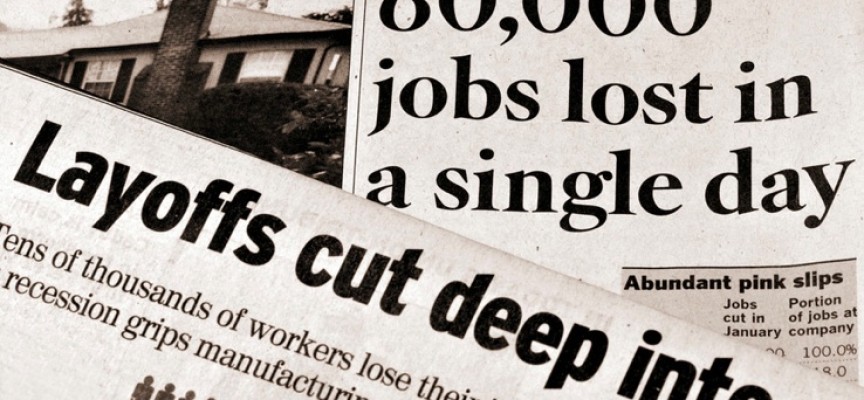Massive layoffs are coming that will intensify the recession by impacting consumer spending, plus a surprising look at housing and travel.
Massive Layoffs
August 23 (King World News) – Gerald Celente: Fifty-two percent of U.S. companies have imposed a hiring freeze, half are planning or beginning layoffs, more than 40 percent have rescinded recent job offers, and an equal number have eliminated hiring bonuses they dangled in a tight labor market, according to a survey this month of more than 700 U.S. employers by financial and business services firm PwC.
Amazon, Apple, Oracle, and Walmart have announced layoffs or freezes in recent weeks.
At the same time, more than 65 percent of firms are raising pay and expanding mental health benefits for workers, the most common such benefit being the option of working remotely.
“Firms are playing offense and defense with their talent strategies,” Bhushan Sethi, co-leader of PwC’s people and organizations practice, told the Financial Times.
Layoffs torpedo employee morale and, if done poorly, can damage reputations, he noted. “People have long memories and social media plays a much bigger role now.”
While 70 percent of companies said they are expanding remote work options, 61 percent said they now require employees to be in a central office more regularly, indicating the hybrid work model is taking hold.
“September is shaping up to be a line in the sand for many companies’ return-to-office plans,” the FT noted, although many such deadlines have been imposed and then abandoned over the past 18 months.
With fewer workers, whether through remote work or layoffs, cutting space costs was the most common cost reduction strategy cited by respondents in PwC’s survey.
Twenty percent said they were reducing office footprints, while 31 percent said they were increasing their space.
TRENDPOST:
The fact that employers are shedding, or poised to shed, workers – many of whom were rehired not long ago after the COVID War – highlights the weakness of the global economy and is another factor raising the risk of recession around the world.
TREND FORECAST:
Reducing office space was the go-to cost-cutting measure cited in the survey.
That underscores the accuracy of our long-term forecast, first made shortly after the COVID War began, that office real estate would not only be a victim of the COVID era but also that the sector would shrink permanently in size and value.
We predicted, and documented, the shrinking need for office space in Office Workers’ Slow Return Endangers Landlords, City Finances, Corporations Continue to Shed Office Space, and As Forecast: Companies Cutting Office Space, and many other articles.
As we noted in Mass Expiration of Office Leases Threatens Landlords, owners of commercial real estate are facing a reckoning as they slash rents to lure a shrinking base of tenants, forcing them to demand property tax concessions from cities that will struggle even more to maintain police, fire, and public works infrastructures.
Although more people are returning to city centers to live, as we reported in “USA: Can’t Afford to Buy a Home, Can’t Pay the Rent”, that will not be enough to fully restore the commercial ecosystem of restaurants, shops, and entertainment venues that grew up to serve a full complement of daily commuters.
As a result, downtown commercial centers in traditional office hubs such as New York City and San Francisco will not return to their pre-COVID size or vitality. We have detailed this trend in articles such as “Retail Chains Abandon Manhattan” and “Manhattan’s Commercial Real Estate Crash”.
Landlords and investors have been contemplating turning empty office spaces into condos and apartments. However, a similar move to convert derelict hotels into residences has been snarled in regulations, which we detailed in “Plan to Turn New York’s Vacant Hotels Into Housing Not Working”…
Look At Who Is A Big Investor In This Soon-To-Be Self Funding Gold Exploration Company! To learn more click here or on the image below.
U.S. HOUSING MARKET CONTINUES TO WEAKEN
In July, U.S. home sales fell to 4.81 million units, 6 percent less than June’s level and 20 percent below that in July 2020 to set the slowest pace since November 2015, except for the early days of the COVID infestation, the National Association of Realtors (NAR) reported.
Sales of homes priced below $250,000 were off 31 percent in July, year over year. Units listed for $750,000 to $1 million lost 8 percent in sales, while 13 percent fewer houses costing more than $1 million were sold.
“In terms of economic impact, we are surely in a housing recession because builders are not building,” Lawrence Yun, the NAR’s chief economist, said in comments quoted by Yahoo.
There were 1.31 million homes for sale on 1 August, the same number a year earlier. That inventory should be enough for about three months’ sales, the NAR noted.
However, homeowners “are absolutely not” in a recession, Yun added. “Homeowners are still very comfortable financially.”
Stubbornly high prices and rising interest rates have largely closed the market to modest- and middle-income buyers, especially first-timers.
Also, since 2019, rents have risen to record heights, making it harder for families to save enough money to make the sizeable down payments that many mortgage lenders now require.
First-time buyers accounted for 29 percent of home sales last month. Pre-COVID, they usually made about 40 percent of home purchases.
However, the high end of the market continues to see a steady flow of deals.
The median home sale price in July was $403,800, down slightly from June and 10.8 percent above that of a year previous, the slowest monthly rise on an annual basis since July 2020.
Newly listed homes spent an average of 14 days on the market, matching June’s speed record for how quickly homes sell.
“Home listings were nearly twice as likely to have had a price cut in July 2022 compared to a year earlier,” Danielle Hale, Realtor.com’s chief economist, said to Yahoo.
TREND FORECAST:
If the housing market is in a recession, it is unlikely to open a large number of new doors to buyers now locked out of home ownership.
A shortage of land, labor, and materials will continue to crimp the number of new homes that can be built. High interest rates and requirements for large cash down payments will keep many working families from qualifying for a mortgage that they could have gotten less than two years ago.
The shortage of available homes is due partly to private equity’s giant footprint in the housing market.
Private investment firms have gobbled up tens of thousands of single-family homes over the past two years to then rent at top dollar to the same families who could have bought the houses not long ago.
We have detailed private equity’s commandeering of the U.S. housing market in articles such as:
“Real Estate Investors Choosing Single-Family Rental Homes” (13 Oct 2020)
“Invitation Homes to Buy $1 Billion Worth of Houses This Year” (1 Jun 2021)
Rents for Single-Family Homes Reach 15-Year High (1 Jun 2021)
“Blackstone Extends Reach Into Housing Market” (29 Jun 2021)
“Private Equity Partners Target $5 Billion in Rental Houses” (27 Jul 2021)
“Residential Rental Rates Skyrocketing” (10 Aug 2021)
“Rents Soar as Investors Buy Properties and Raise Rates” (14 Sep 2021)
“Investors Now Targeting Off-Campus Student Housing” (14 Sep 2021)
“Rents Soaring. What’s Next?” (21 Sep 2021)
“Single-Family Rental Homes: Investments Galore” (16 Nov 2021)
“Home Sales Up as Money Gang Gobbles Up Houses” (23 Nov 2021)
“Rents on the Rise” (11 Jan 2022)
Private equity firms’ invasion of the housing market has stirred some concern among government officials (Private Equity Landlords Draw Regulators’ Attention, but it is unclear what power officials might have to curb the practice.
Meanwhile, as we have often said previously, private equity’s role in U.S. housing is helping to create the first generation of Americans since World War Two that will spend their lives renting instead of being able to build pride, equity, and a sense of belonging by owning their own homes…
ALERT:
Powerhouse merger caught Rio Tinto’s attention and created a huge opportunity in the junior gold & silver space CLICK HERE OR ON THE IMAGE BELOW TO LEARN MORE.

BUSINESS TRAVEL SLOWING
Business travel may not return to pre-COVID levels until some time in 2026, two years later than previously forecast, according to a study by the Global Business Travel Association (GBTA).
A slowing global economy and geopolitical uncertainty surrounding the Ukraine war and the U.S.-Chinese tensions over Taiwan are making companies cautious, CNBC reported.
Also, inflation looms large; the GBTA estimates prices across the economy will continue to rise through next year.
Still, spending by business travelers worldwide will grow by 34 percent this year to $933 billion, the GBTA estimates.
However, that growth will leave the industry still short of the $1.9 trillion it generated in 2019, CNBC noted.
Although hotels’ business-related revenues were $92.36 per available room in July, compared to $88.05 during the same month in 2019, inflation has eaten all of those gains and more.
Occupancy was 63 percent, compared to 67 percent in 2019.
Business travel spending in the U.S. will grow by 42 percent overall this year, reaching $213.4 billion, the GBTA predicted.
TREND FORECAST:
In Trends Journal articles including Bid Farewell to the Business Travel Economy and Europe’s Banks Permanently Slash Business Travel, among others, we have long forecast that business travel will never return to pre-COVID War volumes.
Inflation and higher interest rates are squeezing companies’ margins; businesses will do what they can to save money.
Having become comfortable, if not entirely happy, with Zooming and teleconferencing during the COVID War, bosses now see their positive impact on the bottom line and will make remote contact, not travel, the new normal.
ALSO JUST RELEASED: STUNNING CHARTS: Stock Market Rally Over And Gold Will Benefit As Inflation Continues To Rampage CLICK HERE.
ALSO JUST RELEASED: THIS CAN’T BE GOOD: Retail Traders Buying Market Decline While Pros Are Selling CLICK HERE.
ALSO JUST RELEASED: An Apocalyptic Scenario Is Now Unfolding For The West CLICK HERE.
ALSO JUST RELEASED: BUCKLE UP: More Pain Ahead Is Setting The Stage For A Fed Pivot That Will Rock Global Markets CLICK HERE.
One Of The Most Important Interviews Of 2022
***To listen to one of the most important interviews of 2022 featuring the brilliant Nomi Prins CLICK HERE OR ON THE IMAGE BELOW.
© 2022 by King World News®. All Rights Reserved. This material may not be published, broadcast, rewritten, or redistributed. However, linking directly to the articles is permitted and encouraged.









